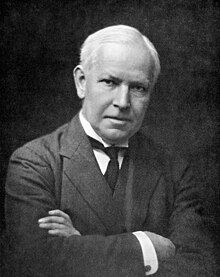Grafton Elliot Smith

Grafton Elliot Smith (third from left) with fellow researchers and fragments of the so-called Piltdown man (around 1910)
Grafton Elliot Smith (born August 15, 1871 in Grafton , New South Wales , † January 1, 1937 in London ) was an Australian anatomist , anthropologist and Egyptologist .
Smith was Professor of Anatomy in Cairo from 1900 to 1909, Professor of Anatomy at the University of Manchester from 1909 to 1919, and from 1919 to 1937 at University College London .
Together with William James Perry (1887–1949) he represented a heliocentric diffusionism that identified ancient Egypt as the cradle of human culture.
Smith had been a member of the Royal Society since 1907 , from which he was awarded the Royal Medal in 1912 . In 1934 he was elected an Honorary Fellow of the Royal Society of Edinburgh .
Fonts
- The Natural Subdivision of the Cerebral Hemisphere . 1901.
- The Primary Subdivisions of the Mammalian Cerebellum . 1902.
- The Ancient Egyptians and the Origin of Civilization . London / New York, Harper & Brother 1911.
- Catalog of the Royal Mummies in the Museum of Cairo . Cairo 1912.
- On the Significance of the geographical distribution of Mummification - a study of the migrations of peoples and the spread of certain customs and beliefs . 1916.
- The Evolution of the Dragon . 1919.
- Tutankhamen and the Discovery of his Tomb . 1923.
- Evolution of Man: Essays . 1924, 2nd edition 1927.
- Human history . 1930.
- The Diffusion of Culture . London, Watts 1933.
Web links
- Literature by and about Grafton Elliot Smith in the catalog of the German National Library
- Works by and about Grafton Elliot Smith in the German Digital Library
- Entry for Smith, Sir, Grafton Elliot (1871-1937) in the Archives of the Royal Society , London
Individual evidence
- ^ Fellows Directory. Biographical Index: Former RSE Fellows 1783–2002. (PDF file) Royal Society of Edinburgh, accessed April 8, 2020 .
| personal data | |
|---|---|
| SURNAME | Smith, Grafton Elliot |
| BRIEF DESCRIPTION | Australian anatomist, anthropologist and Egyptologist |
| DATE OF BIRTH | August 15, 1871 |
| PLACE OF BIRTH | Grafton , New South Wales , Australia |
| DATE OF DEATH | January 1, 1937 |
| Place of death | London |
